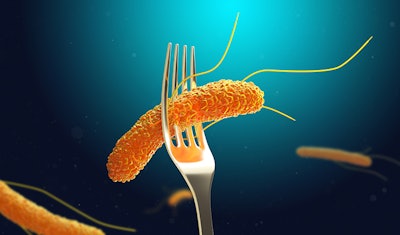
Salmonella control remains a major food safety challenge for the poultry industry. Next generation sequencing technologies, such as CRISPR-SeroSeq, could lead to better detection and management for this important pathogen.
“Poultry has been a significant source of Salmonella outbreaks, and this has continued despite a huge effort by our industry to reduce it during processing,” said Nikki Shariat, PhD, assistant professor in the Department of Population Health, Poultry Diagnostic Research Center, University of Georgia College of Veterinary Medicine.
“This is because some of these serotypes can escape pre- and post-harvest interventions. Currently there isn't a silver bullet that targets all Salmonella.”
Overall, cases of Salmonella contamination in chicken decreased from 9% in 2016 to 6.57% in 2020, however, the number of people infected with Salmonella in the U.S. remained constant over the four-year period.
Shariat is one of the many experts scheduled to speak at the Poultry Tech Summit, scheduled for October 30 - November 1 in Atlanta, Georgia. This one-of-a-kind in-person event facilitates the transition of innovation technologies from researchers and entrepreneurs into commercial applications for the benefit of the poultry industry.
Make plans to attend and take a look at the future of the industry.
Registration for the 2022 Poultry Tech Summit is now open with early bird savings available. Save $200 off if you register by September 30th!
More precise Salmonella detection
CRISPR-SeroSeq, a deep sequencing technique, can identify multiple serotypes of Salmonella within a single sample.
“This is especially valuable as we have shown that Salmonella populations in poultry often consist of multiple different serotypes,” Shariat explained.
“While deep serotyping allows us to look at Salmonella populations, most next-generation sequencing technologies are based on whole genome sequencing of a single isolate with the purpose of being able to characterize individual Salmonella strains for source typing and epidemiology,” she added.
Other next-generation sampling techniques only detect the most populous Salmonella serotype in a strain, which may not be the most likely source of foodborne illnesses in people, and fail to identify the less common, more detrimental serotypes.
Because of this, the ability to detect multiple serotypes within a single sample could help the poultry industry better predict and develop more effective control for preventing Salmonella outbreaks.
Attend the 2022 Poultry Tech Summit
Join an exclusive international gathering of industry-changing innovators, researchers, entrepreneurs, technology experts, investors and leading poultry producers at the 2022 edition of Poultry Tech Summit on October 30 - November 1 in Atlanta, Georgia.
Attendees can expect the same groundbreaking innovation and insightful presentations that made the previous events well-attended with deep dialogue on new prospective solutions and next-generation technologies. Poultry Tech Summit focuses on the transition of innovative technologies into commercial applications to advance the poultry industry.
Registration is now open with early savings available.


















